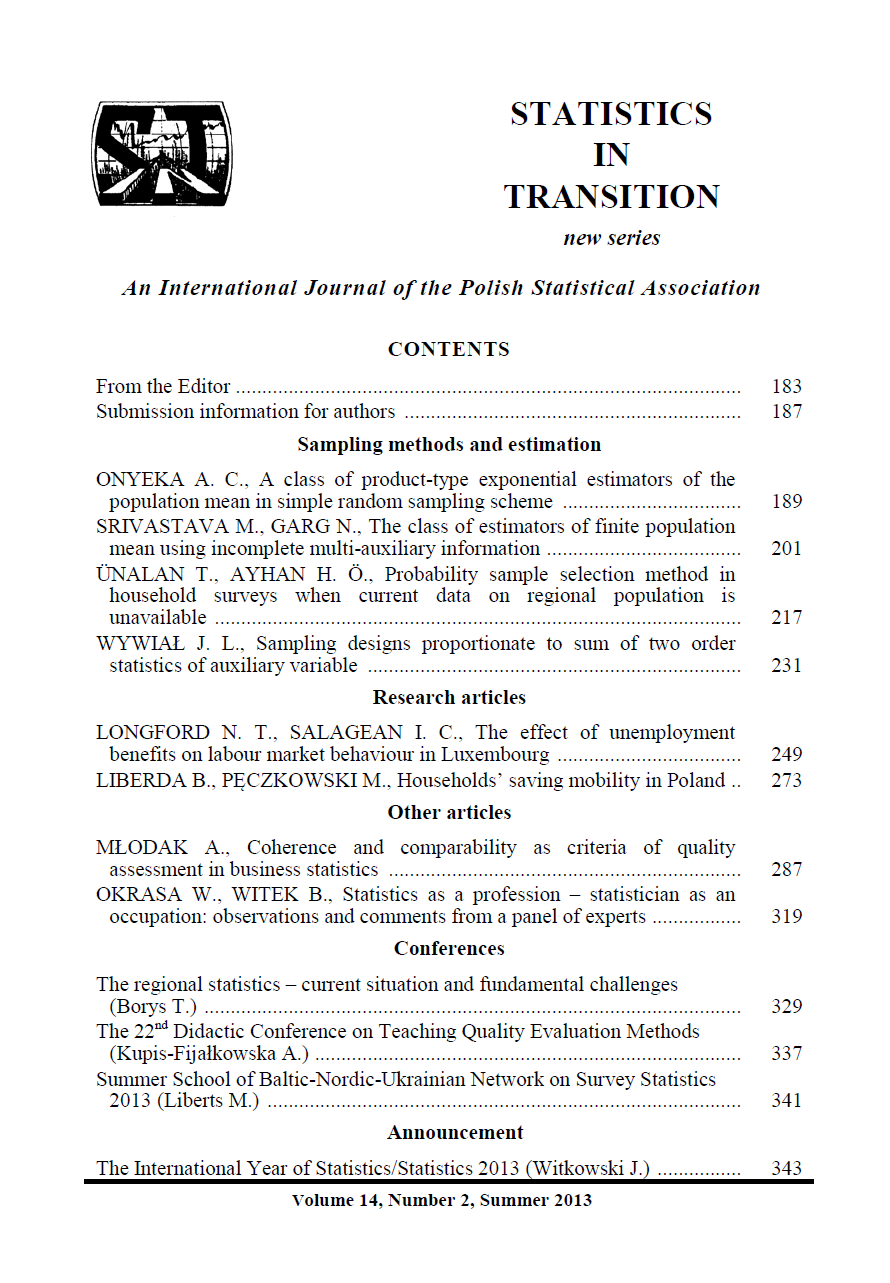ARTICLE
ABSTRACT
Availability of the perfect sampling frame only exists in developed countries, which covers a very small proportion of the world countries. On the other hand, in developing countries lists of the latest population census counts are generally used as the sampling frame for sample surveys. Therefore, in developing countries surveys which are planned for future periods long after the census date, cannot be representative of the related time period if the same census counts are utilized. Instead, population projections and data adjustment methodologies must be used to provide a representative probability selection of the updated population. This article proposes a population projection and adjustment methodology in order to establish the ideal selection probability for household surveys. The method contains the correction on the differences of the sum of strata and aggregated values. Comparative examples are also provided to clarify the proposed methodology
KEYWORDS
data adjustment, household surveys, population projection, projection methodology, sample selection, selection probability
REFERENCES
ALHO, J. M., SPENCER, B. D., (2005). Statistical Demography and Forecasting. Springer, New York.
AYHAN, H. Ö., EKNI, S., (2003). Coverage Error in Population Censuses: The Case of Turkey. Survey Methodology 29 (2), 155–165.
BONGAARTS, J., BULATAO, R. A. (editors), (2000). Beyond Six Billion: Forecasting the World’s Population. Panel on Population Projections, National Academy Press, Washington D. C.
COX, P., (1976). Demography. Cambridge University Press, Cambridge.
DAVIS, H. C., (1995). Demographic Projection Techniques for Regions and Smaller Areas: A Primer, UBC Press, Vancouver.
GROENEWOLD, G., NAVANEETHAM, K., (1998). The Projection of Populations: Data Appraisal, Basic Methods, and Applications. Centre for Development Studies and UN Population Fund, Kerala.
HINDE, A., (1997). Demographic Methods. Arnold Publishers, London.
LEETE, R., (1990). People: User's Manual. Overseas Development Administration, United Kingdom and Economic Planning Unit, Kuala Lumpur. PEOPLE Version 2.0.
LUTZ, W., VAUPEL, J. W., AHLBURG, D. A. (editors), (1998). Frontiers of Population Forecasting, A Supplement to Vol. 24, 1998, Population and Development Review, Population Council, New York.
NEWELL, C., (1988). Methods and Models in Demography. Belhaven Press, London.
POLLARD, A. H., YUSUF, F., POLLARD, G. N., (1974). Demographic Techniques. Pergamon Press, Sydney.
PRESTON, S. H., HEUVELINE, P., GUILLOT, M., (2001). Demography: Measuring and Modeling Population Processes. Blackwell Publishers, Oxford.
ROWLAND, D. T., (2003). Demographic Methods and Concepts. Oxford University Press, Oxford.
SHORTER, F., SENDEK, R., BAYOUMY, Y., (1995). Computational Methods for Population Projections: With Particular Reference to Development Planning, Second Edition, The Population Council, New York. FIVFIV Version 11.0.
SHRYOCK, H. S., SIEGEL, J. S. and associates, (1976). The Methods and Materials in Demography. Academic Press, Inc., Florida.
STATE INSTITUTE OF STATISTICS, (1995). The Population of Turkey, 1923–1994, Demographic Structure and Development: With Projections to the Mid 21st Century. State Institute of Statistics, Publication No. 1716, Ankara, Turkey.
STOVER, J., (1990). Demproj: A Demographic Projection Model for Development Planning, The Futures Group, Glastonbury. DEMPROJ Version 3.0.
T. S. I., (2003). Census of Population 2000. Social and Economic Characteristics of Population, Turkey. Turkish Statistical Institute Publication Number 2759. Ankara, Turkey.
UNITED NATIONS, (1989). Projection Methods for Integrating Population Variables into Development Planning, Volume I: Methods for Comprehensive Planning, Module One: Conceptual Issues and Methods for Preparing Demographic Methods, United Nations Publications, ST/ESA/SER.R/90/Add.1,New York.
UNITED NATIONS, (1990). Projection Methods for Integrating Population Variables into Development Planning, Volume I: Methods for Comprehensive Planning, Module Two: Methods for Preparing School Enrolment, Labour Force and Employment Projections. United Nations Publications, ST/ESA/SER.R/90/Add.1, New York.
VAN IMHOFF, E., KEILMAN, N., (1991). LIPRO 2.0: An Application of a Dynamic Demographic Projection Model to Household Structure in the Netherlands. Netherlands Interdisciplinary Demographic Institute. The Hague, Netherlands.
VAN IMHOFF, E., (1994). Lipro User's Guide, Netherlands Interdisciplinary Demographic Institute, The Hague. LIPRO Version 3.0
